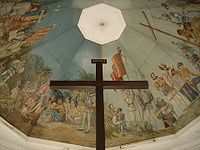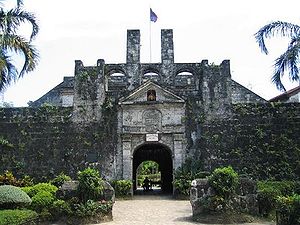“May I ask you a personal question?” Peedy, a personable Cebuano bartender at the Hotel Mercedes in Cebu City, inquired, leaning over with a conspiratorial wink. I looked around behind me. In the atmospheric gloom of the bar, a couple of other Westerners sat hunched over their ron y cokes in the corners, talking to their Filipina wives or girlfriends in hushed tones.
“Sure,” I at last agreed, taking a sip of the ubiquitous San Miguel brew.
“I read much about America in the newspapers. And is it true what they are saying about this.” He cocked his head toward an unattended woman at the bar, looking as bored as a mail-order bride, and raised his eyebrows.
“This VIAGRA!”
Newspapers.
If I paid attention to them I probably never would have come to the Philippines in the first place. Headlines about ferry sinkings with dizzying death tolls and separatist rebels running “amok” (a Tagalog word) did not tempt. Maybe I’d be better off cruising the Caribbean or doing Dollyworld?
In reality though, “Pilipinas” (the Philippines), one of the most idyllic playgrounds in Southeast Asia, has gotten a bad rap.
Mysteriously absent from most Asian itineraries, the Philippines offers some of Asia’s best island hopping among what I found to be arguably the world’s most welcoming people. Filipinos say this is “where Asia wears a smile". In fact, those lusting to get off the beaten tourist track will discover uncrowded beaches light years away from civilization – especially when there are over 7,000 islands to choose from. That means, if you went to a different island each day, it would take you about 20 years to visit them all.
Hence, it’s high time to narrow down the search.
If you are looking for island paradises that won’t pick your pockets, look no farther than the amazing Magellanic maze of the Visayas, an island hopper’s dream. Although the Visayan Islands offer such sights as the Chocolate Hills of Bohol and the white sandy beaches of Boracay, I decided I couldn’t see every island in a few weeks. I’d stick to Cebu Island and nearby offshore islands.
This was a tough decision, especially when I could have seen one of the mystical “Bubble Men” of Siquijor, a mysterious island with a reputation for witchcraft and magic. Perhaps a Bubble Man could have directed me towards the world’s most perfect beach!
The country’s oldest conurbation, Cebu City, with its international airport on nearby Mactan Island, is the perfect place to begin exploring. So I jumped in a “jeepney” – a colorful converted jeep left over from WWII – and took off into the unknown.
Arriving at Colon, the oldest street in the Philippines, we headed through a veritable maze, with Filipinos in untucked barong tagalog shirts frying up fish on streetcorners, heading counterclockwise in time toward Magellan’s Cross.
Ferdinand Magellan actually was not the first man to circumnavigate the globe. Whereas one of his ships and some crew completed the perilous voyage around the globe, an achievement that makes even the moon landing look lame, Magellan was actually killed halfway through the voyage – in the Philippines.

 Magellan Cross
Magellan Cross
Erected by Magellan after the first Catholic Mass in the Philippines (April 14, 1521), Magellan’s Cross, I thought, was a good symbolic starting point to begin my proverbial “Visayan Adventure". I’d make my own sort-of circumnavigation around Cebu, but unlike Magellan, I planned to make it back home to tell the tale.
Filipinos are overfond of saying they spent “300 years in the convent and 50 years in Hollywood". While the Spanish and Americans left behind their colonial cultural stamp – it’s Asia’s only mostly Catholic country where almost everybody speaks some English – I try to discover what is distinctly Filipino in this enigmatic domain. As a sign of where I was, during one taxi ride, the driver turned off his radio, blasting covers of American pop music, every time we passed a church!
“Look, Mister John!” Juan, the driver said, pointing at the Basilica Minore del Santo Nino, a reminder of why this country has many Asians (including my driver) who sport Spanish names.

 Front entrance of Fuerza de San Pedro
Front entrance of Fuerza de San Pedro
After a few days exploring the sedate hubbub of Cebu City, frequenting “turo-turo” (point-point) restaurants where you point at plates of what you want to eat, I headed to Fort San Pedro. Named after the ship that brought Miguel Lopez de Legazpi to Cebu in 1565, marking the start of Spanish colonial rule, the historic fort begged to be explored. Built in 1738 as a defense against pirates, the fort, which today houses the National Museum, was variously a stronghold of Filipino freedom fighters against Spain in 1898, a U.S. Army barracks, and a prison camp during the Japanese occupation of WWII.
I was the only visitor on that day. So after touring the fort, the sun beating down on me like a blazing blood orange, I did what everyone else was doing.
The beach! Time to join them. Though Cebu itself has fine beach resorts, I headed to the budget paradises of Bantayan and Malapascua islands off Cebu’s north coast.
On the one-hour ferry ride from Hagnaya to Bantayan Island, aboard an old clunker carting loads of egg cartons, I felt the thrill of being in motion toward a veritable undiscovered tropical paradise of sandy beaches and coconut palms. A buzz is beginning to build around Bantayan though, still it is relatively obscure.
As a sign that the times were changing, I met a friendly collegiate-looking American named John, who turned out to be a writer for Let’s Go, the travel book series researched by globetrotting Harvard students.
After arriving in the port of Santa Fe, which resembled something out of a Tintin comic, I took a “trishaw” (bicycle rickshaw) to Budyong Beach Resort, where I got a traditional nipa hut right on the beach for a haggled ten bucks a night. Dazed days. Narcoleptic nights.
Time stretched and yawned into over a week. I slowly roasted in the sun and watched the video of stars playing in the night sky – more stars even than Imelda Marcos has shoes.
Then one day while I was lingering over a dish of squid adobo, the hotel staff informed me that today was a “fiesta". With so many chickens wandering around without mates, this meant – what else – cockfights were about to begin.
Bantayan is sometimes jokingly referred to as “Egg Island" since it supplies millions of eggs to other islands. There isn’t much to do here except swim, fish and collect coconuts. So the fiesta is an excuse to do something. The few tourists on the island were rounded up and divvied into departing “tricycles” (moped taxis). I decided to hoof it, walking through the village of dirt roads and corrugated-roofed houses, joining the excited crowd wending their way to the violent rooster romp.
At the cockpit, a makeshift mini-coliseum of wire and wood, the crowd pushed in like desperate Wall Street traders, many of them gesticulating wildly, dancing on tiptoes, or jumping urgently to catch the action.
Other wiser spectators stood on fold-up chairs on the periphery. Roosters were rounded up. Bets were placed. Stomachs were hardened. Lots of money was changing hands amid ear-drum-pounding shouting. The stakes were high. A Filipino casador (bookmaker) told me the minimum bet was 500 pesos (over $10.00), which is a lot of money here, but informal bets between friends seemed to be rampant.
Here and there bare-chested men ran about carrying cocks with menacing knife blades, or “spurs", attached to their legs. I picked my bird, which had the confident swagger of a Mick Jagger and waited for him to come up.
Shrewd entrepreneurs sold cold beer, soft drinks and snacks out of coolers. An old man gave up his spot near the fence out of courtesy, still, I found it difficult to get more than a glimpse of the action. The matches didn’t last long – was it minutes or seconds – as the red-helmeted roosters flew into each other like gladiators in a Roman ring.
When my stomach had had enough, I promptly fled, my curiosity about cockfights permanently satisfied.
Yet that night at Bantayan’s best restaurant, the Majestic by the Sea, everyone still dined on “chicken” adobo – at least we thought it was chicken. Cock-a-doodle-doo!
To bail out of Bantayan, I chartered an adventurous “Special Ride” by outrigger to an island paradise that travelers say is similar to the more touristy Boracay: it’s small enough to walk around, but without the crowds. And Malapascua (“Bad Christmas”) Island is, despite its name, the perfect place to vacation – no cars, no banks, no post office, just a few isolated fishing barangays (villages) and one tourist attraction: a lighthouse.
As I approached the island by outrigger, Malapascua poofed up out of the ocean like an uneven banana pancake. I jumped off the boat onto the stunning white-sand Bounty Beach and blundered into a scene resembling a purple-prose guidebook description. With a poetry of palms writ across the beach, I chose from one of a few basic “resorts” offering twenty-dollar huts right on the beach with modern bathrooms, mosquito netting and electric fans.
If you arrive in the off season (our summer), as I did, the resorts are almost deserted, though every day the boats pick up and drop off a few travelers to talk to, mostly from Europe and Australia.
“In my grandfather’s time, there were many fish!” said a Malapascuan named simply “Boy” (a common name in the Philippines), sadly referring to the dynamite fishing that has damaged the coral reefs and affected the fish population. Yet here you’ll still find delicious dishes from the deep. At an informal eatery called Ging Ging’s Flower Garden, made up basically of two picnic tables, I had a chance to try some of them, with names like “lapu-lapu” and “samin-samin” – washed down with glasses of "kalamansi juice", made from Ping-Pong-ball-sized limes. Not bad for the equivalent of a couple of dollars.
Here was the real Philippines, one that could change rapidly if and when mass tourism arrives to this remote outpost.
Then a boat pulled in with German backpackers and Australian expats with Filipina girlfriends, all exclaiming “It’s so cheap!” That, my friends, was the sign that it was high time to leave, Poseidon willing.
At last I stood in the very spot where Ferdinand Magellan met his demise. The place was Mactan, an island off the coast of Cebu connected by bridge, with luxury resorts, frequented mostly by Japanese and Taiwanese tourists, lining the coast. At the site of Punta Engano is an obelisk with a Janus-faced plaque, which true to Philippine form, elusively tells two sides to the same story:
“On this spot Ferdinand Magellan died on April 27, 1521, wounded in an encounter with the soldiers of Lapu Lapu, chief of Mactan Island. [And then it goes on to lengthily sum up the achievement of the world’s first circumnavigation.]
And on the reverse side:
“Here on 27 April 1521 Lapu Lapu and his men repulsed the Spanish invaders, killing their leader Ferdinand Magellan. Thus Lapu Lapu became the first Filipino to have repelled European aggression.”
This sort of coin-flip duality summed up my own feeling for the Philippines.
As I prepared to depart this chain of island-shaped quotations and return to the U.S., trading in coconuts for Coca-cola, beachwear for business suits, and sunshine for civilization, I felt like I was ending one adventure to begin another.
Read the author’s bio here.